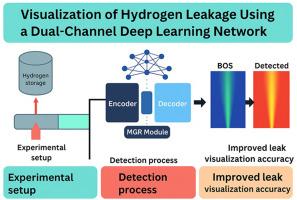Hydrogen leakage diagnosis and visualization of density and pressure using Background Oriented Schlieren with Dual-Channel MGR-Net
IF 8.3
2区 工程技术
Q1 CHEMISTRY, PHYSICAL
引用次数: 0
Abstract
Accurate detection of hydrogen leakage is critical for safety in high-pressure hydrogen systems used in fuel cell vehicles, where even minor leaks can lead to severe deflagration risks. Conventional detection methods, relying on fixed-location sensors and manual inspection, are labor-intensive, slow, and unsuitable for large-scale, real-time monitoring. Background-Oriented Schlieren (BOS) imaging offers a non-invasive visualization approach, but its diagnostic accuracy is limited by conventional displacement extraction algorithms such as cross-correlation and optical flow. This study introduces a novel dual-channel Multi-Granularity Residual Network (MGR-Net) with transfer learning to overcome these limitations. The architecture employs a dual-channel input structure and specialized MGR Block and MGR Module for enhanced feature fusion, significantly improving diagnostic precision. Experimental results show a Dice coefficient of 81.88 %, exceeding ResUNet++ (77.34 %) by 4.54 percentage points, while reducing model size by 78 % and maintaining real-time processing at 42 frames per second, demonstrating both superior accuracy and efficiency for BOS-based hydrogen leak detection.

基于双通道核磁共振网背景纹影的氢气泄漏诊断及密度、压力可视化
准确检测氢气泄漏对于燃料电池汽车使用的高压氢气系统的安全至关重要,即使是轻微的泄漏也可能导致严重的爆燃风险。传统的检测方法依靠固定位置传感器和人工检测,劳动强度大,速度慢,不适合大规模、实时的监控。背景定向纹影成像(BOS)提供了一种非侵入性的可视化方法,但其诊断精度受到传统位移提取算法(如相互关联和光流)的限制。本研究引入了一种新的双通道多粒度残差网络(mrr - net),并结合迁移学习来克服这些限制。该架构采用双通道输入结构和专用的MGR Block和MGR Module,增强了特征融合,显著提高了诊断精度。实验结果表明,该方法的Dice系数为81.88%,比ResUNet++(77.34%)提高了4.54个百分点,同时将模型尺寸缩小了78%,并保持了42帧/秒的实时处理速度,证明了基于bos的氢气泄漏检测具有较高的精度和效率。
本文章由计算机程序翻译,如有差异,请以英文原文为准。
求助全文
约1分钟内获得全文
求助全文
来源期刊

International Journal of Hydrogen Energy
工程技术-环境科学
CiteScore
13.50
自引率
25.00%
发文量
3502
审稿时长
60 days
期刊介绍:
The objective of the International Journal of Hydrogen Energy is to facilitate the exchange of new ideas, technological advancements, and research findings in the field of Hydrogen Energy among scientists and engineers worldwide. This journal showcases original research, both analytical and experimental, covering various aspects of Hydrogen Energy. These include production, storage, transmission, utilization, enabling technologies, environmental impact, economic considerations, and global perspectives on hydrogen and its carriers such as NH3, CH4, alcohols, etc.
The utilization aspect encompasses various methods such as thermochemical (combustion), photochemical, electrochemical (fuel cells), and nuclear conversion of hydrogen, hydrogen isotopes, and hydrogen carriers into thermal, mechanical, and electrical energies. The applications of these energies can be found in transportation (including aerospace), industrial, commercial, and residential sectors.
 求助内容:
求助内容: 应助结果提醒方式:
应助结果提醒方式:


